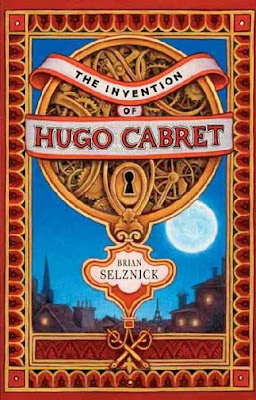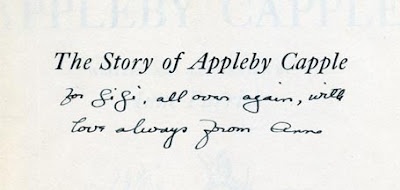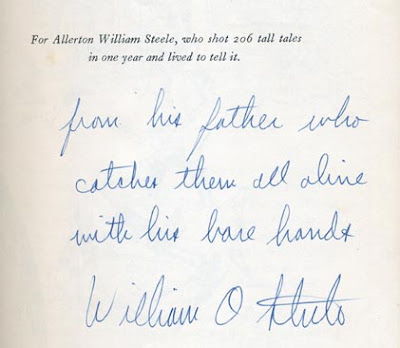TONIGHT’S THE NIGHT
Normally Anaheim, California is best known for Disneyland...but this weekend the city of flying teacups is hosting the American Library Association’s Annual Conference. The highlight for children’s book enthusiasts is tonight’s presentation of the Newbery and Caldecott Medals to Amy Laura Schlitz (for GOOD MASTERS! SWEET LADIES!) and Brian Selznick (for THE INVENTION OF HUGO CABRET.)

Every Newbery-Caldecott Banquet has its own lore. Eleanor Estes tripped and fell as she got up to give her speech in 1952. Linda Sue Park gave the medal to her father right in the middle of her speech. Robert C. O’Brien bowed out of delivering his own acceptance speech. William Steig gave a notably brief speech and far too many authors have given speeches that were far too long. It will be interesting to hear what happens at tonight’s event. Both authors have broken new Newbery/Caldecott ground, with Ms. Schlitz winning for a book of dramatic monologues (the first volume of its type to get the Big N) and Mr. Selznick winning for a picture book over 500 pages long.

Former medalist Susan Cooper (who won the Newbery for THE GREY KING) once referred to the newly-crowned winners as “midsummer monarchs,” and it's true that it won’t be long before we begin anticipating what books will win next year’s awards. But tonight belongs to Good Masters, Sweet Ladies, and Hugo Cabret.
STAYING POWER
It happened again on Friday.
I subscribe to several listserves devoted to children’s and young adult books. Librarians submit “stumpers” -- books that patrons are seeking, though they can’t recall the titles. On Friday a librarian wrote that a patron was a looking for a book about a New York city girl who returns home early from a family vacation and ends up getting a part in a Woody Allen movie.
If I had a dime for every time someone wrote in asking about this book!
The title is THE RISE AND FALL OF A TEENAGE WACKO, published in 1981.

Three other stumpers I frequently see are:
“Does anyone know the title of a book about two 'outsider' girls who form a friendship based on their shared psychic abilities?”
That book is I’M NOBODY! WHO ARE YOU?, published in 1974.
Then there’s “I’m trying to remember a book about a girl who suffers from nightmares, steals small items from stores, and has mysterious scars on her hands.”
That’s STEP ON A CRACK, published in 1978.
Finally, there’s this stumper: “Does anyone know an epistolary novel about two girls who send each other letters while they are on summer vacation? I remember that one girl is opposed to riding in cars because she’s concerned about pollution.”
That one is THERE’S A PIZZA BACK IN CLEVELAND, pubished in 1972.

What all these books have in common is that they were written by the same author: Mary Anderson. (PIZZA was co-authored by Hope Campbell.)
Active in the 1970s and 1980s, Mary Anderson was never a hugely-popular author, nor did she win any awards. I believe all of her books are now long out of print.
But obviously they have never been forgotten by readers -- and that includes me.
I often ask myself what it is about Mary Anderson’s novels that makes readers remember them ten, twenty, thirty years after publication and try to track them down? Is it the characters? The plots? Or some ineffable quality that’s impossible to name?
I too have been drawn back to these books every few years. When I begin re-reading them, I tell myself that I will objectively figure out what makes these stories linger in the mind and haunt the reader...but after a few pages I forget that I’m trying to be a literary detective and find myself falling completely into the enjoyment of reading these books.
Could that be the secret of why people remember Mary Anderson’s novels -- that they are simply really, really good books?
Or is there something else between the lines that draws us in and makes us never forget?
GINGER PYE, PINKY PYE, AND JOHNNY PYE
Well, I knew the first two as children’s books by Eleanor Estes, but had never heard of Johnny Pye until I stumbled across JOHNNY PYE AND THE FOOL-KILLER in the library stacks the other day. I was surprised I didn’t know it -- especially since it was written by Stephen Vincent Benet, who won the 1929 Pulitzer Prize for Poetry for JOHN BROWN’S BODY and the classic 1937 short story THE DEVIL AND DANIEL WEBSTER.

The book concerns a “biddable” orphan boy who seeks to avoid the “fool killer” (death) by sampling life as a snake-oil salesman and merchant, trying out the military, and considering politics before, inevitably, accepting death as an elderly man. This moving and old-fashioned story has the feel of a fine folktale.
Published in 1938, this novella-length book is so short that I was able to read the entire thing during my half-hour lunch break at work. Though the book I held in my hands was seventy years old, many of the pages were uncut and I frequently had to wipe off my lunch knife and score the edges so I could continue reading the story.
No wonder I felt like I was discovering something new and unknown as I read JOHNNY PYE AND THE FOOL-KILLER; I was actually the first person to EVER read the library's copy. Imagine that!
I’LL GET THERE. IT BETTER BE WORTH THE TRIP.
It has to have been a full year ago that my friend in California told me that A DARKLING PLAIN by Philip Reeve was a great book and urged me to read it. Unfortunately, it turns out that DARKLING PLAIN is the fourth and final volume in a series called “The Hungry Cities Chronicles.” My friend said it wouldn’t make any difference if I plunged directly into the fourth volume, but I felt it wouldn’t be right if I didn’t read the other three volumes first. So I rushed out and got paperback copies. I read MORTAL ENGINES right away and, even though fantasy isn’t my favorite genre, I enjoyed this fast-paced and inventive novel. That was last summer.
Just today I finished reading the second volume, PREDATOR’S GOLD and enjoyed that as well.
I’m going to start #3, INFERNAL DEVICES, tomorrow, but considering my track record (and the fact that the book is over 400 pages) who knows when I’ll finish it.

Incidentally, A DARKLING PLAIN is nearly 600 pages.
I expect to finally finish it by Christmas.
...Christmas 2009.
SUMMER WHINE
There’s nothing a blogger loves more than getting plenty of hits on his blog.
For the past couple days I’ve had about two hundred new visitors. Of course I was ecstatic. But I noticed that they were all coming to read the exact same entry -- from February 24, 2008. I went back and re-read that entry and couldn’t see anything that might suddenly attract all that attention.
Today I discovered that a school library listserve had been discussing the “Mickey Mantle scene” in Gary Schmidt’s THE WEDNESDAY WARS and that someone had posted a link to my blog entry containing Mr. Schmidt’s explanation of that scene. I believe my blog is the only place on the internet (till now, at least) that offers this information -- and of course I am thrilled to share it with anyone and everyone who drops by here. This blog is all about sharing information on old and new children’s books.
However, I have to say I was slightly chagrined to see that, with maybe one or two exceptions (out of 200+ new visitors) nobody hung around to look at anything else on the blog. Wouldn’t you think that school librarians...book people...readers...would have their curiosity sufficiently piqued by the WEDNESDAY WARS information that they’d at least look at a few more blog entries just to see what other info on children’s books is available here? Whatta bummer.
SUMMER WINE
So to all the REGULAR VISITORS here, I’d like to extend a big THANK YOU for your continued readership and support.
I'm grateful to the old friends who suggested I start this blog and the new friends who have either posted comments here or sent me e-mails (at Newbery13@aol.com.)
And I'm grateful to those anonymous readers whose cities keep showing up in my “stat counter” from Australia (wow -- around the world!) and Berkeley, California...Williamsport, PA...just down the 696 expressway from me in Ann Arbor and Brighton, MI...Manchester, NH...Indianapolis ...Kansas...Stowe, VT...Germantown, MD...and dozens of others. (And if you log in through America Online, I don't know WHERE you live, because all AOL visitors are funneled through Reston, VA.)
As a way of saying thanks:
Have you all read DANDELION WINE by Ray Bradbury?
I somehow missed this title growing up -- but one of my co-workers, who is very widely-read, always talks about DANDELION WINE being her all-time favorite. In fact, she talked about it so much that I finally had to read it myself!
And of course I fell in love with it...because everybody loves this book.
A couple years later, I was able to repay the friend who introduced me to this book by telling her that Ray Bradbury would be appearing at a local bookstore. She was able to have her battered paperback of DANDELION WINE signed and thank Ray Bradbury in person for writing her favorite book.

I think anyone who loves children’s books would enjoy this collection of inter-connected stories about twelve-year-old Douglas Spaulding’s summer in tiny Green Town, Illinois. Tinged with fantasy and nostalgia, DANDELION WINE celebrates the simple joys of being young and alive. And it’s the type of book that deepens as the reader ages -- and begins to notice the intimations of mortality and loss that lurk in the shadows of summer.
If you haven’t read it before, you might want to give it a try.
If you have read it before, you might want to read it again.
It’s the perfect summertime gift to share with others.
Pass it on.












































